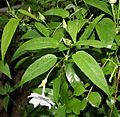Thunbergia facts for kids
Quick facts for kids Black-eyed Susan vine |
|
|---|---|
 |
|
| Scientific classification | |
| Kingdom: | |
| Division: | |
| Class: | |
| Subclass: | |
| Order: | |
| Family: | |
| Genus: |
Thunbergia
|
| Species: |
T. alata
|
| Binomial name | |
| Thunbergia alata Bojer ex Sims
|
|
Thunbergia is a group of beautiful flowering plants. They belong to the Acanthaceae family. These plants are originally from warm, tropical places like Africa, Madagascar, and southern Asia. Many people know them by different names. For example, Thunbergia alata is often called the Black-eyed Susan vine. This name comes from its pretty flowers that look like they have a dark "eye" in the middle. Another common name for some Thunbergia plants is clockvine.
The name Thunbergia was given to these plants to honor a famous Swedish botanist named Carl Peter Thunberg.
Contents
What is Black-eyed Susan Vine?
The Black-eyed Susan vine (Thunbergia alata) is a very popular climbing plant. It grows quickly and can cover fences, trellises, or walls. It's loved for its bright, cheerful flowers. These flowers usually have five petals and come in colors like orange, yellow, and white. The most special part is the dark purple or black center, which makes them look like an eye.
Where Does It Grow?
This plant loves warm weather. It grows naturally in tropical parts of Africa. Because it's so pretty, people now grow it all over the world in gardens. It can be found in many warm countries. In places with cold winters, it's often grown as an annual plant, meaning it lives for only one growing season.
How to Grow Black-eyed Susan Vine
Black-eyed Susan vines are quite easy to grow. They need a lot of sunshine to produce many flowers. They also like soil that drains well, so water doesn't sit around their roots. If you want them to climb, you need to give them something to hold onto, like a trellis or a fence. They can grow quite tall, sometimes up to 6 to 8 feet (about 1.8 to 2.4 meters) in a single season!
Caring for Your Vine
To keep your Black-eyed Susan vine happy, water it regularly, especially when the weather is dry. You can also give it some plant food to help it grow stronger and produce more flowers. Removing old, faded flowers (this is called "deadheading") can encourage the plant to make even more new blooms.
Other Types of Thunbergia
While Black-eyed Susan vine is very well-known, there are many other types of Thunbergia plants. They all have their own unique beauty.
Blue Trumpet Vine
One example is Thunbergia grandiflora, often called the Blue Trumpet Vine or Bengal Clockvine. This plant has much larger flowers, often in shades of blue or purple. It's also a strong climber and can create a beautiful display of color.
Orange Clockvine
Another interesting type is Thunbergia gregorii, known as the Orange Clockvine. Its flowers are a bright, solid orange color without the dark eye that the Black-eyed Susan vine has. It's also a lovely plant for gardens.
Life Cycle and Reproduction
Like most flowering plants, Thunbergia plants reproduce using seeds. After the flowers are pollinated, they form seed pods. These pods contain the seeds, which can then be planted to grow new vines. Bees and other insects help to pollinate the flowers, moving pollen from one flower to another. This process is essential for the plant to make seeds and continue its life cycle.
Images for kids
See also
 In Spanish: Parra Susana de ojos negros para niños
In Spanish: Parra Susana de ojos negros para niños






